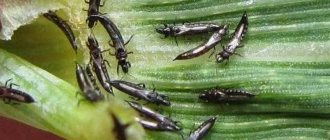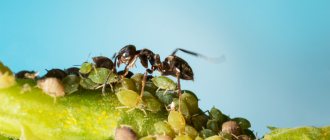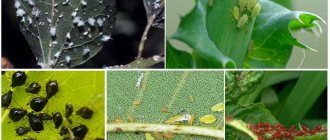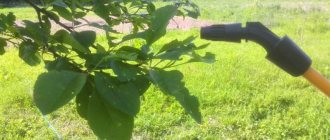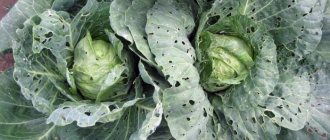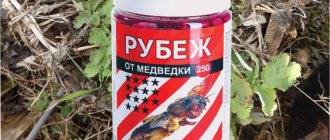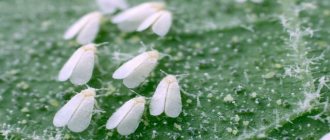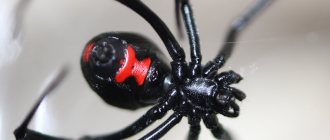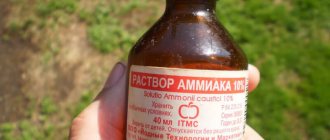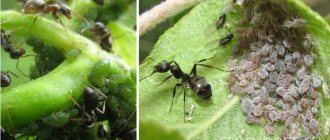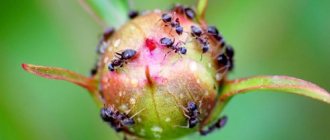Home / Pests and diseases
Back
Published: 06/09/2019
0
5/5 — (1 vote)
One of the main pests on the plots is aphids. Despite the small body size of up to 2 mm, this insect has such a huge population that it devours large areas in a few weeks, not disdaining either fruit trees, flowers, or garden crops. One of the most dangerous species is the black aphid, which has a dark brown or black color on its oblong back and feeds on plant sap using a long proboscis.
- 1 Development cycle, reproduction and distribution
- 2 How to deal with black aphids
- 3 Home recipes or folk remedies:
- 4 Prevention
Development cycle, reproduction and distribution
In late autumn, aphids leave clutches of eggs in fallen leaves, uncollected dried weeds, at the roots of trees and in the axils of the bark, which are successfully preserved throughout the winter. In the spring, larvae are born from the eggs, which begin to feed on the juice of young leaves and buds during flowering, growing into adults.
Within a month, aphids are capable of occupying several hundred square meters of land, migrating using their wings from one garden to another, from vegetables to trees. When developing, aphids secrete a sweetish, sticky white mass, attracting a huge number of ants, which then guard the aphids all summer and spread them to neighboring plants. Green aphids behave almost the same way. During the season, several cycles of development of new generations of females occur.
The main victims of aphid attacks are:
- Coniferous trees - pine, cedar, spruce. By damaging young needles, by the beginning of summer, aphids leave deformed yellow needles on the branches with a white air coating in which new larvae are hidden.
- Fruit trees - cherry, viburnum, sweet cherry. Literally a week later, massive black dots appear on the leaves and shoots, devouring the trees during the flowering period.
- Vegetables - cucumbers, tomatoes, beets, peppers and even sorrel and dill. The black-gray shades of the aphid body can be easily seen on trunks and branches, at the base of ovaries and leaves.
- Berries, shrubs and flowers - jasmine, strawberries and wild strawberries are the favorite delicacies of black aphids. Signs of the lesion are visual deformities in forms covered with sticky dew.
What harm can it cause?
Aphids can have a severe negative impact on affected plants. If we are talking about flowers or plants from the garden, pests, sucking out all the juices from vegetables, trees, bushes, flowers, can leave the owners of the plot without a harvest. Plant leaves wither without nutrients and moisture and subsequently dry out. Next year, such trees or shrubs may not produce a harvest at all.
Read this article on how to get rid of aphids on trees and shrubs.
In addition to the above mentioned insects, cereal aphids are very dangerous. She lives on oats, barley, spring and winter wheat, rice, millet, and sorghum. If such insects are not removed in a timely manner, the entire grain crop may be destroyed due to the rapidly increasing population of parasites.
Aphids can also greatly harm the plants that people grow at home. These are flowers, vegetables and herbs growing on a windowsill or in a greenhouse. Pests are able to enter a house with flowers already favored by parasites or during the period when females with wings are moving.
Important! Plants that are attacked by pests are first deformed. If no action is taken in a timely manner, they will dry out completely. On flowers, a clear sign of the presence of parasites is the falling of buds that have not yet had time to bloom.
Undigested juice, which is secreted by insects, forms a special film that does not allow oxygen to penetrate to the plants. In this regard, the process of photosynthesis is disrupted, which additionally creates good conditions for the appearance and reproduction of fungus (sooty fungus). All this together causes the death of plants.
How to deal with black aphids
It is necessary to destroy the insect pest promptly, comprehensively and thoroughly, affecting all possible areas of distribution. The fight against black aphids has several directions: mechanical, agrochemical and home methods.
Mechanical methods:
- Applying adhesive gels to tree trunks and branches, using sticky fly strips to tie around the trunks. Not only aphids, but also ants fall into the traps, which is doubly effective.
- Getting rid of anthills on the site.
- Watering shrubs and crops with strong water pressure from a hose. The aphids cling very weakly, so they wash off well. Requires repeated use.
- Destruction with gloved hands, crushing with fingers. This is used for single individuals, but is not effective due to the presence of larvae.
Agrochemical methods for black aphids:
- The spark is golden. Combined insecticide with double action. Suitable for vegetables and flowers, trees and berries. Black aphids on strawberries die within a few hours. One tablet per 10 liters of water. After two weeks it is non-toxic to humans. Spray adults.
- Dichlorvos. It is quite effective, but it is better to use in small quantities, purchasing modern aerosols without a strong odor.
- Trichopolum. A medicinal product that has no pronounced effect, but is used by gardeners due to the lack of toxic effects on crops and humans.
- Inta-vir. Actively paralyzes the nervous system of parasites. The disadvantage is the negative impact on beneficial insects. Use 1.5 tablets per 10 liters of water. Processing no more than once every two weeks, preferably in dry weather.
- Commander. It seeps well through the roots and stems to the leaves. It also affects the nerve receptors of the insect and it dies. Remains on the leaves for a long time and is toxic to newly emerged larvae. The concentration required for treatment is 200 g per 1 liter of water.
- Cortlis. Made specifically against sucking and gnawing insects, it works in solution for several weeks. Take 5 ml per 10 liters of water for treatment.
- Aktara. It is often recommended to use in conjunction with other chemicals. They water the roots and spray the leaves. Phytotoxic.
- Tanrek. It has proven its effectiveness on open ground and in greenhouses. Often used when black aphids already have a large population. Does not affect beneficial insects.
- Corado. Combinedly destroys aphids and Colorado potato beetles. Used over large areas.
- Biotlin. A widely popular substance that poisons insects when they eat it. It works in a couple of hours. All proportions are indicated in the instructions.
- Fitoverm. Biological preparation, quickly neutralized in water. Therefore, use only in dry weather. It poisons the insect and after two days the maximum effect is achieved. Does not affect animals and humans.
- Karbofos. It only affects sexually mature individuals and has a specific repellent odor. Not expensive.
- Fufanon. A strong drug that affects not only parasites, but also kills fungal pathogenic cells.
- Alatar. You need to purchase 10 ampoules for the season. Poisons parasites through the gastrointestinal tract. It has a complex composition, therefore it is much more effective than other means.
Description of the pest
Aphids are small sucking insects measuring 2–3 mm; some species reach 5–7.5 mm. The pest's body is soft and elliptical. The color can be green, gray, red, brown, beige, black .
The insect's head is trapezoidal in shape with antennae on the forehead. Compared to other insects, aphids have a complex visual system. The pest distinguishes a wide range of colors - from red-green to blue-violet.
Aphids pierce plant tissues with a proboscis , which in different species can be short and blunt or long and sharp. Winged individuals have two pairs of transparent membranous wings on the thoracic region, one of which is larger than the other.
The legs of aphids are long and thin; in females, on the hind legs there are glands with odorous substances that attract males. The insect's abdomen is covered with tubercles or white fluff in the form of a waxy white coating. It protects the insect from contamination and from water droplets.
Home recipes or folk remedies:
- A weak aqueous solution of Ferry clogs the pores and respiratory tract of aphids with foam.
- Garlic infusion is prepared overnight by placing a crushed head of garlic in 10 liters of hot water.
- One ampoule of ammonia (ammonia purchased at a pharmacy) is mixed with a bucket of water.
- A pack of cheap cigarettes is boiled for half an hour in 10 liters of water, then left for two days. Fill the roots and spray the leaves.
- Smoke bombs for fumigating the area.
- Aphids are very afraid of pollination with pure ash. Wood ash can also be infused with onion peels in water and watered on the soil.
- An effective remedy may be half a kilogram of potato tops infused in 5 liters of water, to which it is recommended to add laundry soap.
Damage to cucumbers
An aphid invasion is observed in the second half of summer. At the end of July, aphids actively reproduce and are located in entire colonies on the underside of leaf blades. The pest causes damage to cucumber bushes and causes:
- yellowing and curling of leaf plates;
- slowing down the growth of vegetable crops;
- loss of green space vigor;
- lack of ovary;
- death of bushes;
- falling off of developing fruits.
Aphids secrete sugary juice, which promotes gluing of leaf plates. The liquid attracts various garden pests.
Prevention
To prevent the appearance of black aphids on the site, it is necessary to follow the general rules for the care and prevention of the garden. It is necessary to collect and burn all the weeds and old bark in the fall. Treat plants and trees with a solution of lime at the roots and lower trunk parts. Clean the greenhouses, paint the shabby areas, open the doors for the winter. Treat the soil with insecticides and water with biological preparations for fertilizing.
Attention to your farm and the desire to get a good, healthy harvest motivates the gardener to actively fight pests using the methods described.
5/5 — (1 vote)
Methods of destruction
To kill aphids you can use:
- chemical insecticides;
- folk remedies;
- mechanical methods;
- biological methods.
Biological methods are called attracting insects and birds that feed on aphids to the site. Biological methods automatically exclude the use of pesticides, since in this case beneficial insects will also be destroyed.
Paths of plant infection
Preventing plant infestation by black aphids is quite difficult, as it occurs in a variety of ways:
- In summer, when doors and windows are open, winged females can fly into a greenhouse or plant room.
- The pest can travel long distances on people's clothing or animal fur.
- A newly acquired plant or tree may already be infected with aphids and infect other plantings.
- Aphid eggs or larvae may be in the soil.
- Aphids can be carried and planted on plants by ants.
Hermes
The founder has a black shiny body. Subsequent generations are covered with white fluffy hairs.
- Geographical distribution. Everywhere where there are coniferous trees.
- On what plants is it found? Any conifers, especially spruce, pine, larch and cedar.
- Development. Incomplete. 4-5 generations appear per season.
- Maliciousness. They disrupt the development and fruiting of trees, weakening their protective abilities and reducing their decorative properties.
Cucumber (melon)
The elongated body with a sharp rear tip is colored in different shades of green. The antennae and paws are black.
Melon aphid photo.
- Geographical distribution. Everywhere.
- On what plants is it found? Melons, cucumbers, beets, cotton, tobacco, peanuts, sesame, citrus fruits, eucalyptus.
- Features of development. Parthenogenetic reproduction, development is incompletely cyclical. Several generations of asexual virgins change over the course of a season. Fertility - 40-50 individuals per female.
- Harm caused. This variety is one of the most harmful. Causes great damage to plants due to high fertility.
Preventive measures
To prevent infection of cucumbers , experienced farmers recommend:
- choose varieties that are resistant to insects;
- tighten ventilation holes in greenhouses and greenhouses with gauze or fine mesh;
- cover bushes in open beds with a thin cloth;
- simultaneously fight ants;
- carry out frequent weeding;
- disinfect seeds before sowing;
- treat the soil and greenhouse with disinfecting compounds (potassium permanganate, copper sulfate);
- in the fall, use sulfur bombs for disinfection;
- periodically change spray preparations to prevent addiction;
- do not plant seedlings too densely;
- regularly apply mineral and organic fertilizers.
Leaf gall
Wingless females have an oval body , colored yellow or pale green. The antennae are long and dark. Winged females are much smaller and have a pair of transparent wings. The body is brownish-brown.
- Geographical distribution. Everywhere.
- On what plants is it found? White, red and black currants.
- Features of development. Full cycle.
- What harm does it cause? By sucking the juices from the leaves, it forms galls on them - swellings of burgundy or yellow color. Young bushes are damaged the most; the population can destroy the plant.
To protect plants, you can use chemical agents to control aphids.
Carrot
The elongated oval body is pale green in color, the antennae are short and light, as are the paws.
- Geographical distribution. Everywhere.
- On what plants is it found? On carrots and other umbrella plants.
- Development. Full life cycle.
- What harm does it cause? The leaves curl, the nutrition of root crops deteriorates, so the quality and quantity of the harvest suffers.
Symptoms of cucumber damage
The following signs will help you recognize the presence of aphids on cucumbers::
- slower growth and flowering;
- curled, drooping and dry upper leaves;
- areas covered with honeydew;
- ants scurrying around the plant;
- fall of the ovaries;
- wilting of the lower leaves;
- many small black bugs on the back of the leaves.
Cabbage
It has a broad oval pale green body and short dark antennae.
Cabbage aphid photo.
- Geographical distribution. In almost all countries, in Russia it is absent in subtropical regions.
- On what plants is it found? It lives mainly on cruciferous vegetables, especially likes radishes and cabbage.
- Development. In warm climates, development is incomplete, in other areas - a full cycle. During the season, from 6 to 30 generations appear.
- What harm does it cause? Reproducing en masse, it adheres to the entire plant, which leads to death.

